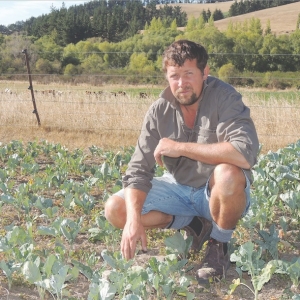However, if steady rain doesn’t arrive soon the damage will spill into 2015-16 and even beyond.
“If we get real rain before the end of February we should be able to salvage milk production and while the winter feed crops won’t be what they could have been, they’ll be okay,” Federated Farmers Dairy South Canterbury chairman Ryan O’Sullivan told Dairy News.
“Milk production will be down and feed costs will be up, but it will not be a disaster.”
That best case scenario would see his 2014-15 output 10% below budget but with irrigation gone and cows already on 16-hour milking, that could climb to 25-30% if the drought doesn’t break soon.
Meanwhile, a looming shortage of winter feed could see cows go into 2015-16 in poor condition, affecting production and in-calf rates, which in turn would impact in 2016-17. “I don’t know where the winter feed will come from. You can’t buy it if it’s not for sale.”
Palm kernel is available, apparently without limit, and at 20-23c/kgDM it’s one of the few feeds that isn’t loss making at the current payout forecast, but there’s a limit to how much can be used, he adds. “You need some fresh material to go with it: grass, silage or baleage and that’s in great shortage.”
O’Sullivan’s quick to point out that while their farm is in one of worst hit areas, as an established business of seven years they should be able to “push through”, but new entrants, whether share farming or in other business structures, will be under huge stress due to the pincer of payout and drought. “They’ve not had that payout from last year to help see them through.”
Cashflow forecasts through to next Christmas show the losses will really start to stack up in the winter and spring, especially if there’s no better payout forecast for 2015/16, he adds.
“If it’s $4.70/kgMS then the $2.80/kgMS or so advance isn’t going to cover anything more than farm working expenses. If this [GDT] recovery firms and builds, and the forecast’s $6 with a $4 advance, that’s going to be a lot better to survive on.”
O’Sullivan says he’s been fortunate to get 250 heifer calves which are normally grazed on their supporting land around the 340ha, 1250-cow platform, away to irrigated grazing in Central Otago. Another 90 are still at home, grazing lucerne on riverflats usually conserved as baleage. “There’s not enough to make it worth baling.”
Feed for the calves sent away is certain, thanks to Clutha River water, whereas their home farm’s extraction from the Tengawai River, which is managed as part of the Opuha scheme, was stopped at new year. The farm’s 360,000m3 pond kept the grass growing through January but now it’s all but empty. “There’s about 600mm left in it… We’re keeping that as emergency stock water. Stock water’s OK at the moment but the Tengawai is critically low.”
The drought highlights central South Canterbury’s big problem, he says. “The Orari, Opihi and Pareora catchments are some of the most water-short catchments in the whole of Canterbury… It is not inconceivable that Timaru could run out of water in three weeks. That’s a major New Zealand town without water. It would be unprecedented.”
Canterbury’s Water Management Strategy recognises the problem, yet opposition to the most practical solution – bringing water over Burkes Pass to supplement the Opihi and possibly Pareora catchments – remains considerable.
“The Opihi’s going to run dry but only 20 minutes drive to the north there’s 250,000L/sec pouring out to sea [in the Rangitata River]. The Godley, Cass and Macauley Rivers that feed Lake Tekapo would be no different.”
With climate change predictions of increasingly frequent drought in the South Island’s east but more rain on the Southern Alps, accessing such supplies isn’t so much to grow the region’s economy as to protect what’s already there, he adds.
“The Egyptians would have done it thousands of years ago. Low reliability irrigation is destructive for farming systems and wealth because farmers lack the confidence to invest.”
In their own case the drought has seen three employees who left through “natural attrition” this season not replaced, and plans to buy a new tractor and build another house shelved.
While O’Sullivan’s take from the Tengawai has been off since New Year, those “downstream of the dam” in the Opuha scheme have been getting 50% of their supply so have managed to keep the grass green, if not growing to its potential, he says.
However, the current prediction is the lake will run out February 20 at which point releases from the dam will be matched to inflows, and unless there’s rain, the Opihi, which supplies irrigation water to those downstream and delivers much of Timaru’s domestic and industrial water, will run dry. Flows in the Pareora, which supplements Timaru’s supply, are little better.
Respite reaches North Otago
Rain south of Timaru and into North Otago last week brought relief from the drought but how long it lasts remained to be seen, O’Sullivan’s North Otago counterpart in Feds, Lyndon Strang, told Dairy News.
“By the colour of the river I’d say it’s just very rapid run-off,” he said of the Kakanui River which supplies his farm’s irrigation. “We might get six or seven days’ out of it then we’ll be all but shut down again.”
However, for most dairy farms in North Otago that wasn’t likely because they’re supplied by the Alpine-fed Waitaki, as are most of those in South Canterbury south of Timaru, he pointed out.
More of a worry for those farms, as for all in the drought affected area, is winter feed, much of it grown on surrounding dryland, he says.
“The irrigated winter feed crops are great but they are few and far between. A lot of the wintering here is done on the dryland and those crops are looking very sad to say the least.”
Supplement supplies are also down, contractors reporting 50% less made than last year “or worse,” says Strang.
“If you don’t have good winter feed crops you’re going to have to make up the feed with something and you need to be planning that now.”
With little or no cashflow likely come July, and possibly nothing available, buying now could be a good option. He also echoes Dairy NZ’s advice to consider drying off cows at BCS 5.0.


















